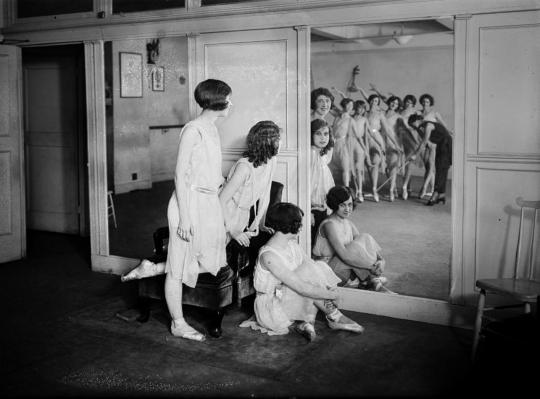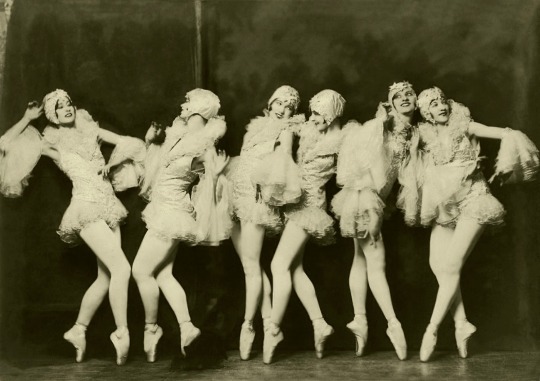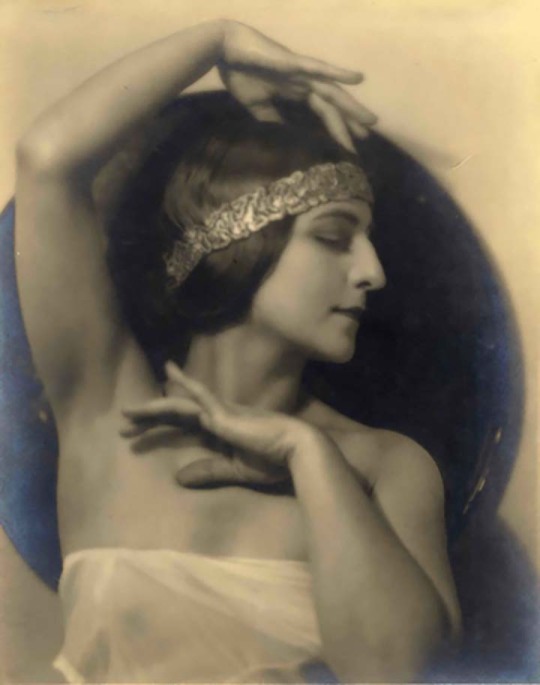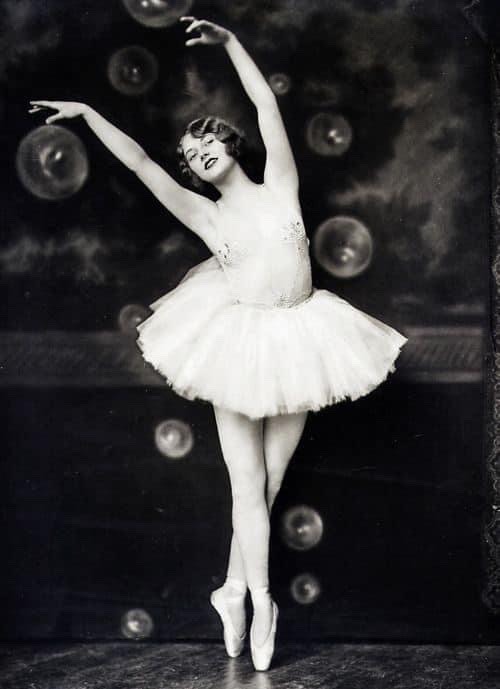#albertina rasch
Text

The Albertina Rasch Dancers with Harriet Hoctor in the Ballet of the King number in The Three Musketeers, a musical based on the novel by Alexandre Dumas père. It opened at the Lyric Theater on March 13, 1928, and ran for 318 performances. William Anthony McGuire adapted the book for the stage; music was by Rudolf Friml and lyrics by P.G. Wodehouse and Clifford Grey. Florenz Ziegfeld was the producer. The show starred Dennis King, Douglass Dumbrille, Reginald Owen, and Vivienne Segal.
Photo: White Studio via Songbook1
#vintage New York#1920s#Ziegfeld#Broadway musical#Three Musketeers#Albertina Rasch#dancers#dancing#P.G. Wodehouse#Rudolf Friml#Florenz Ziegfeld#Harriet Hoctor#William Anthony McGuire#Vivienne Segal#Dennis King#Douglass Dumbrille#Reginald Owen
109 notes
·
View notes
Text
Albertina Rasch dancing

Photograph shows choreographer and dancer Albertina Rasch (1891-1967) dancing, between 1920-25. Glass negative. George Grantham Bain Collection. | src Library of Congress

"Rasch dancing" • The Viennese ballerina and choreographer Albertina Rasch, glass negative. George Grantham Bain Collection. Shorpy date it 1915, while in the Library of Congress it's dated between 1920-1925.
view more on wordPress
#albertina rasch#danseuse#danzatrice#Tänzerin#bailarina#dance pose#dancer#Bain News Service#g.g. bain#1920s#women artists#portrait#role portrait#george grantham bain#George Grantham Bain Collection#LofC#Porträt#retrato#ritratto#portret#retrat#Bildnis#Rollenporträt#rollenportrat
122 notes
·
View notes
Text

1927 Ziegfeld Follies Act I Finale called "Stars and Stripes". On stage are the Albertina Rasch Dancers, Ziegfeld showgirls and dancers and a female band called "The Ingenues". From Art Deco, Avant Garde and Modernism, FB.
97 notes
·
View notes
Photo

Ballet dancers trained by choreographer and dancer Albertina Rasch (1891-1967), reflected in a mirror. circa 1900.
84 notes
·
View notes
Photo

Troupe de danse d'Albertina Rasch pour le spectacle “Rio Rita” à Brodway - New York City - 1927
2 notes
·
View notes
Photo

Edward Steichen - Albertina Rasch Ballet Group (Margaret Jacobson, Claire Deerfield, Jeanette Bradley, and Clayton Estes), June 1931
14 notes
·
View notes
Text
BROADWAY MELODY OF 1936

For its first 20 minutes or so, THE BROADWAY MELODY OF 1936 (1936) seems the most pedestrian of musicals, despite Jack Benny’s comic timing as a Walter Winchell-style Broadway columnist and Francis Langford’s song stylings. Then Eleanor Powell gets her first dance solo and for at least a little bit the jokes seem funnier and everything else just feels better. The callow, young Robert Taylor even looks like a better actor. It seems like forever before Powell gets back into her tap shoes, and the film flags. It took a while for MGM to realize that audiences didn’t want to see Powell dancing, however skillfully, in an Albertina Rasch ballet or lip-synching a soulful ballad or even stumbling through love scenes. They just wanted to see her tap. Maybe it’s the androgyny of it all, but this Kinsey Six finds her feverish dancing in a sequined tuxedo incredibly sexy. The plot involves a feud between Benny and Broadway producer Taylor. To jinx Taylor’s new show, Benny invents a French superstar who’d be the perfect leading lady for Taylor but can’t take his calls because she doesn’t exist. When Taylor’s secretary (the wonderful Una Merkel) catches on to the con, she takes it a step further by convincing Powell to masquerade as Mlle. Arlette. Powell’s interpretation of the diva is like some of Jeanette MacDonald’s better comic moments except that instead of belting out high Cs at key points Powell dances. In the finale, some well-placed closeups shot by Charles Rosher under Roy Del Ruth’s direction virtually anoint her as the saint of the dance floor, come to tap us all out of the Great Depression.
youtube
4 notes
·
View notes
Text
You've Come a Long Way, Baby
You’ve Come a Long Way, Baby
Those of us who still remember cigarette ads on television will recognize the tagline that heads this blog–“You’ve come a long way, baby,” was the jingle for Virginia Slims–which in 1968 was a new, thin cigarette from Phillip Morris marketed specifically to women. October 29, 1927 cover by Julian de Miskey. The campaign launched by the Leo Burnett Agency sought to make Virginia Slims an…
View On WordPress
#1920s advertising#1920s fashion#Albertina Rasch#Anne Harriet Fish#Barbara Shermund#Broadway#Chesterfield cigarettes#Clare Briggs#Dorothy Parker#Ernest Hemingway#Harper&039;s Bazar#Janet Flanner#Jazz Age#Old Gold cigarettes#Paul Poiret#Roaring Twenties#Smokador#The New Yorker#Virginia Slims#women smoking#Women&039;s liberation
0 notes
Photo

#Ziegfeld Follies#1931#1930s#Albertina Rasch Dancers#black and white vintage photograh#ballet#beautiful#old film
8 notes
·
View notes
Video
Albertina Rasch with members of her troupe by Selma Morgenstern
The Steinway building, Midtown, 1925
#bnw#Photography#photograph#vintage#1925#Steinway building#nyc#new york city#dance#dancers#danse#b&w#ballet
1 note
·
View note
Text

Austrian-American choreographer and dancer Albertina Rasch (1891-1967) by unknown photographer | src Dimitri Tiomkin official website
view more on wordPress
#albertina rasch#danseuse#danzatrice#dance pose#portrait#circle#dancer#Tänzerin#bailarina#late 1910s#Porträt#retrato#ritratto#portret#retrat#Bildnis#tanzpose#unknown photographer#1910s
134 notes
·
View notes
Text




Albertina Rasch Dancers in the Ziegfeld Follies of 1927, Helen Brown Rainbow of Girls
Brown, Helen Hayes: [ACJ] ibdb.com and ibdb.com - Helen Brown performed in the Ziegfeld Follies of 1927 and in Ziegfeld's musical The Century Girl (1916-1917, as Miss Brown).
#HelenBrown #ZiegfeldFollies1927 #AlbertinaRaschDancers #FricPic
1 note
·
View note
Text
Mary Howard: Of "Borneo" and Broadway
Mary Howard: Of “Borneo” and Broadway

Mary Howard (1913-2009) first came on to my radar as the ingenue in the Frank Morgan classic The Wild Man of Borneo (1941), originally devised as a vehicle for W.C. Fields. Her credits were not voluminous but she did make a mark in show business and the arts.
Born Mary Rogers in Independence, Kansas, Howard studied dance with Albertina Rasch and others in her youth. Two older sisters were in the
View On WordPress
0 notes
Text
“Is Ballet dying? I couldn’t disagree more” -Misty Copeland
Our journey through ballet’s substantial history continued through this week, as we went full dive into the analysis of ballet being this flexible art form. Putting ballet into this idea of it being a language and that those who speak it or learn to speak it, are able to gain agency within it and begin to make new choices. I would say that within our last week’s readings, we discussed many choreographers throughout time who achieved exactly that – contributing to the expansion of the movement vocabulary that lives within ballet. This week’s readings looked at ballet through a 20th and 21st century lens. The first reading The Rise of American Ballet, had a concentration around how ballet was established in the United States. There was mention of many pioneers such as Albertina Rasch, Adolph Bolm, Lincoln Kristein, and George Balanchine – a few of the many that set the ground works for ballet’s thriving pulse within the States. It also went on to explain that ballet was not able to set roots within the United States in the 19th century because many people believed it to be foreign owned. At the time, the United States also lacked serious American companies that were capable of fostering proper training. Although ballet was not able to thrive completely on its own, it still existed within the context of the Musical Theater realm. Major contributing factors to ballet being established in the States, was Lincoln Kristein’s initiative to bring George Balanchine to New York to start his own company. Balanchine dealt with a lot of criticism surrounding his work, such as people claiming that it’s not “American” enough due to his foundations lying in Russia. Despite all of that, Balanchine cultivated his own interpretation of what ballet is and how it was presented. Finding satisfaction and beauty within simplicity.
Other Notes…
What is American?
Balanchine’s experimental choreography – adding to this concept of ballet being flexible
A ballet that lives within America, that has this American accent on it – making it this interesting new take on the style
Creator vs. Content
This week’s class, in particular, engaged in an active debate surrounding this question of – what does it mean to actually be trained? Individual interpretations were extremely diverse and added a lot to our knowledge as a whole
The next readings, consisted of two articles – Misty Copeland Called Out a Russian Theater for Blackface & Hiplet – An Implausible Hybrid Plants Itself on Pointe. I found these two articles interesting because they addressed two important topics that surround not only the ballet world, but the art of dance as a whole. The article about Misty Copeland brought to light the racism that is present in the ballet world. Being the first African American principle dancer in a major dance company and having a social media presence, Copeland used her platform to address this issue that she feels extremely strong about. Based on our discussions about this article – I think it is important to consider the very specific lens that we Americans have when it comes to racism, and how maybe we project that onto to other cultures. It was mentioned in class that it’s crucial to take into considerations all perspectives and digging up the intention behind an action, rather than seeing the action from a surface level standpoint. The second article talked about, Hiplet – a hybrid of pointe and hip hop created by Homer Hans Bryant. It brings attention to how these two opposite styles can live in one dance form and be presented with contradictions to popular belief. This was an informative reading because it re-iterated this concept of ballet not being this dying art form but rather a style that is ever-changing
Other Notes…
This debate around Copeland projecting an American issue onto Russia – where is the line between an obligation to address a major issue and realizing that other cultures are not America and they do not have the same history as us, therefor their approach is coming from a less tainted view
Copeland’s article sparked a major interest in what racism looks like through other cultural lenses? Does it live in other cultures the same way as it does for America? I’ve only ever been exposed to racism in the United States – to research this would be really neat and intriguing
Hiplet is an obvious attempt to bring something new to the table. However, after discovering that it does not equally emphasize training in both practices, can it really be a fuse of the two?
I also find it cool to read about how these inventions within ballet are happening now while we grow and learn
0 notes
Photo

Just Pinned to Arts/Decos: Ferdinand Preiss bronze and ivory sculpture "cabaret girl" based on a photograph of Dorissa Nelova [Albertina Rasch Dancers]. http://ift.tt/2oLNRjd
0 notes
